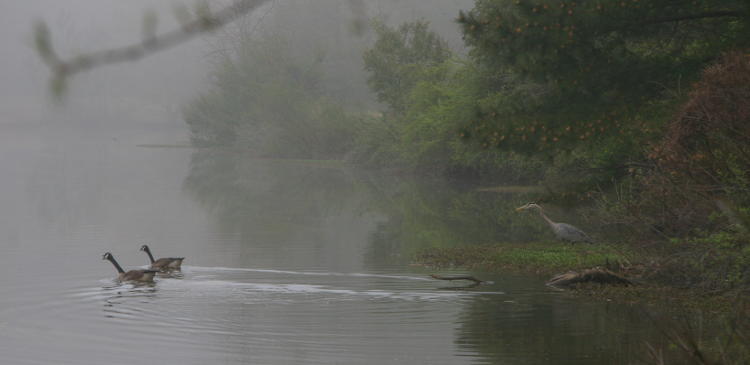
Quick one here, a shot from a few weeks back, to remind you that tomorrow, May 11th, is World Migratory Bird Day, so go out to your favorite big box store and purchase yourself a brand new migratory bird. Or, perhaps, just get outside and try to spot or photograph a few, or feed some, or learn about some, or pretend you’re one and run north and south – whatever works. Once again, I’m going to be a little tied up this day, so I’m not sure what I might produce myself, and I’m not the biggest bird photographer (got about another 32 kilos to go.) But we’ll see what happens, I suppose.
Just because, part 29
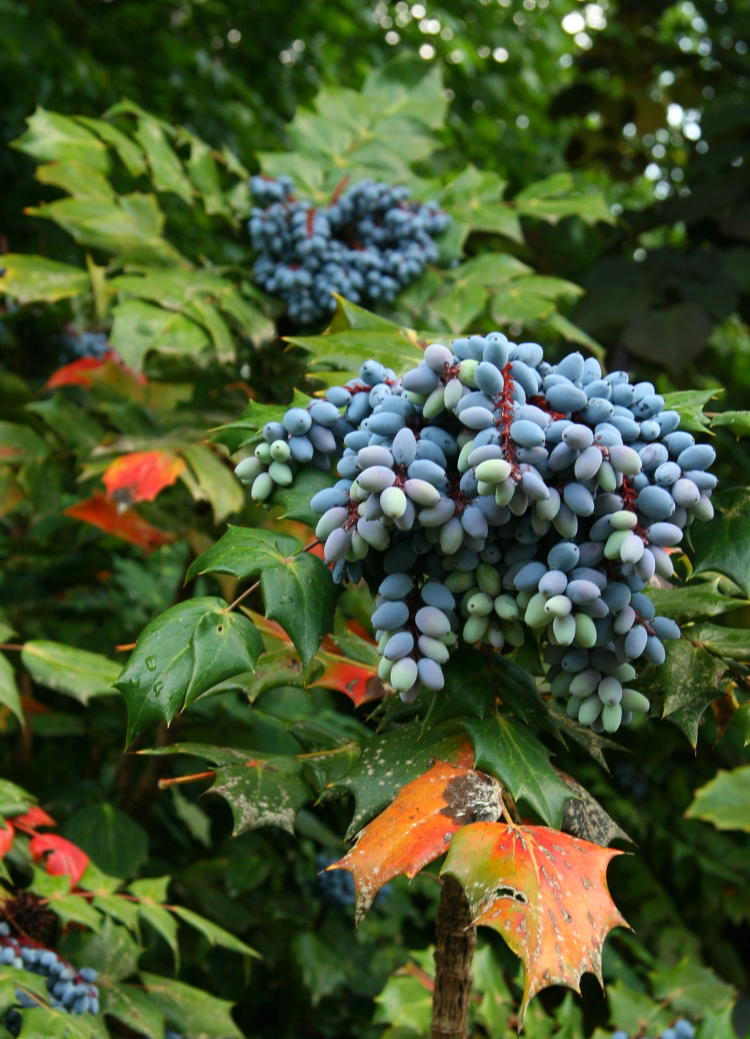
Not enough time to research this bush to find out what it is – it appears to be a variety of holly to me, but that’s all I’m permitted to tell you. This didn’t fit in with the other images I have stacked up awaiting a more detailed treatment, so it appears here without further exposition. But aren’t those berries cool looking?
How did you do?
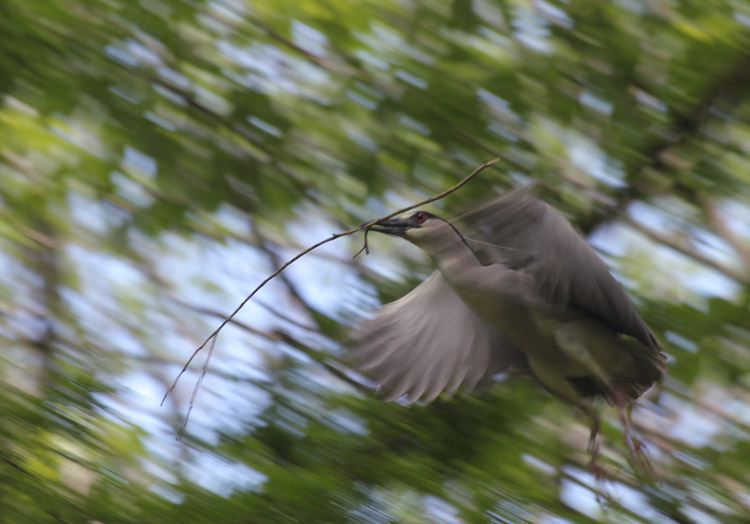
As you undoubtedly know, because you’re on a nature photography blog, today is Nail The Pan Day, the day when we successfully pan the camera with a moving subject and keep it sharp. For my submission, I present this black-crowned night heron (Nycticorax nycticorax) heading out with a bit of nesting material. Note the linear blur of the background, as well as the ghostly effect on the wings, while the eyes and even the twig remained pretty damn sharp. Ordinarily, you might credit this more to luck, but it is a distinctive nature photography holiday, so you have to admit that would be a hell of a coincidence.
I will readily note that this is a captive, so a lot easier to get this close than a wild specimen, but that doesn’t affect panning technique – if anything, it’s harder because the motion is greater. I’ll provide more details in a few days, because I’m typing this on a touch-screen right now and it’s pissing me off, but I had to prove that I was on top of the holiday.
I been busy, part 1
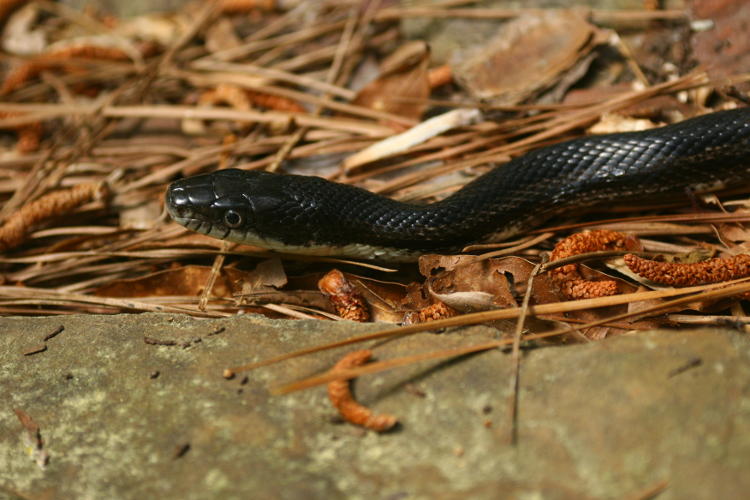
We’ll start off with a snake. Everybody loves snakes, right?
All of the images herein came from one trip to a local botanical garden a little over a week ago (I’m hedging because I don’t know when this will post) – a very busy day there as far as visitors, so this napping black rat snake (Pantherophis obsoletus) surprised me a little, given that it was snoozing right next to a bench. But it was in a sparsely-visited portion of the garden, and had remained unbothered. Mr Bugg and I managed to creep up on it for some closeups, which is what convinced me that it was asleep – snakes don’t have eyelids and thus sleep with their eyes open, and sometimes, as long as you don’t cross open sky or throw a shadow onto them, their brains never register your proximity. Cast a shadow across them, though, and they’ll take off like a shot. This one finally started stirring after a minute of our shenanigans, but we were already close at that time and I suspect this didn’t register as high on the threat level as approaching would have, though I’m only speculating now. Either way, we left it there to finish its nap.
Most of what we saw that day were waterfowl, though, and that was because they get free food and aren’t bothered by crowds. Oh, and flowers, of course, but there’s only so much you can do with flowers.
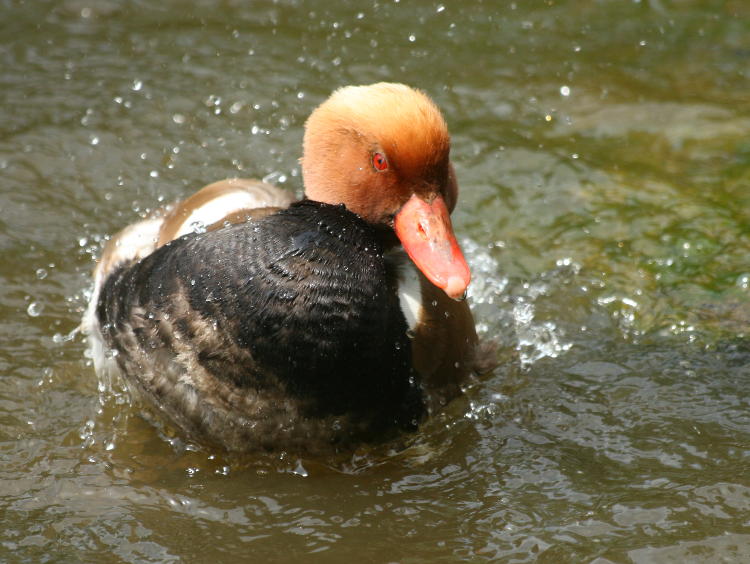
Not all of the ducks found there are native – the gardens feature a variety of resident exotics, like this red-crested pochard (Netta rufina) which is from Europe/Asia. Still, in such circumstances one can take the opportunity to get some behavioral shots that would be much harder to accomplish with a truly wild/feral species, and so we fired off a bunch of frames as this one preened and groomed itself. The bright light and its proximity allowed for some detailed and brief frames, so the water drops could be captured in midair.
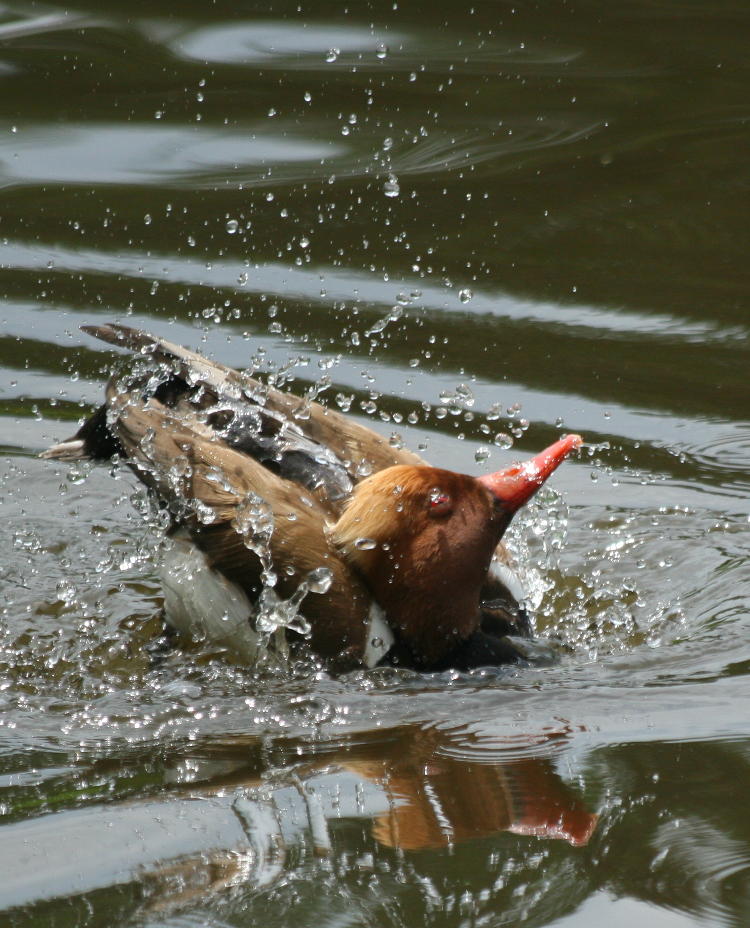
Sometimes, what you end up capturing is something a bit warped looking, which is part of the fun. There aren’t too many expressions that birds can display, so we interpret body positions as an indication, usually incorrect, of what’s going on or their underlying emotions. Like awkwardness. But my favorite lies below, with that little portion of the open beak poking out – you can almost imagine it stepped in an unexpected hole.
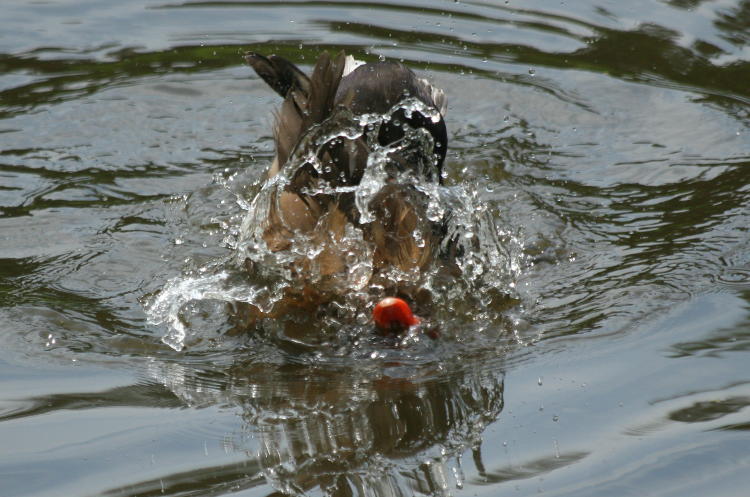
Other times, you might be observing behavior and trying to determine exactly what is going on, which can be exceptionally tricky – we filter everything through our own social structures and expectations, which have no application whatsoever to any other species, and truly knowing what’s going on socially among another species takes long experience and often the input of other, more knowledgeable people. Like this shot of two different species, a mallard (Anas platyrhynchos) on the left and a northern pintail (Anas acuta) on the right.
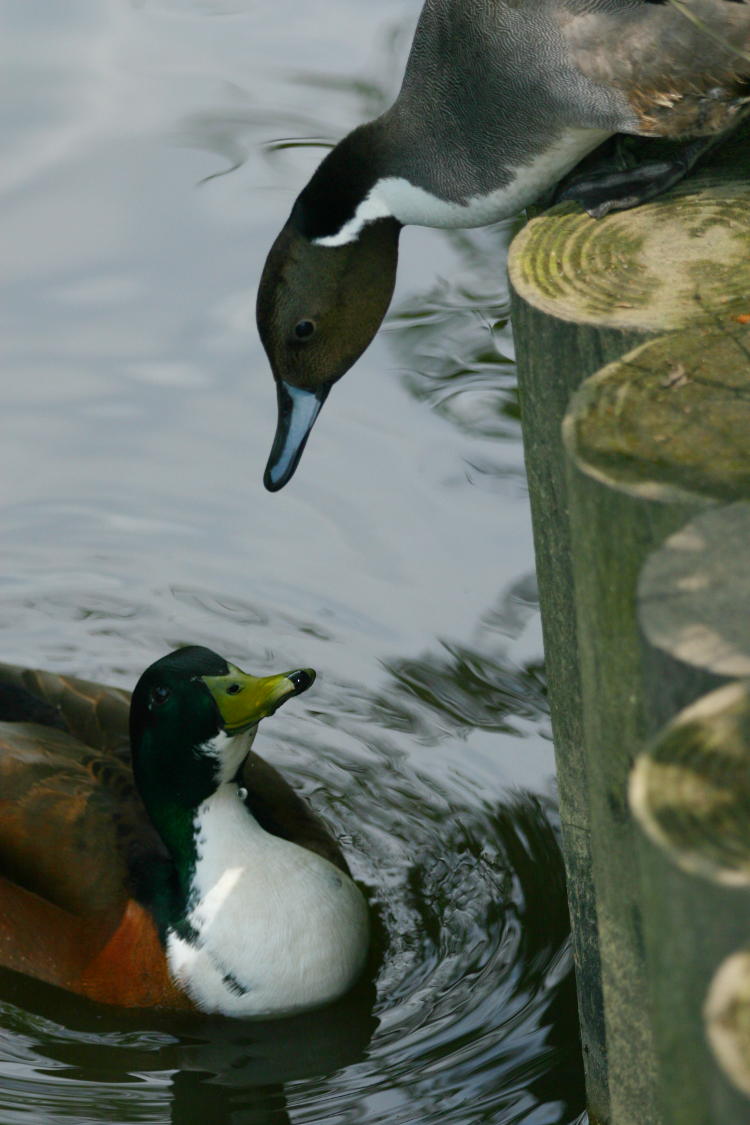
They certainly look to be interacting in some manner, like a neighbor leaning over her fence to share some gossip (all that we’ve seen have been males, by the way,) and someone more familiar with territorial protective instincts might have expected a squabble (heh, “squabble.”) But the completion of this tableau was anti-climactic; the pintail simply plopped into the water alongside the mallard and swam off a little ways. To the best of my knowledge, the mallard was swimming up just as the pintail decided it needed to go for a dip, and there was a momentary pause as they encountered one another – basically, the mallard in the way and perhaps wondering what was on the pintail’s mind as it loomed overhead, neither threatened or even concerned about the presence of the other. But at least, as the pintail swam out, it presented a nice profile to show off its plumage.
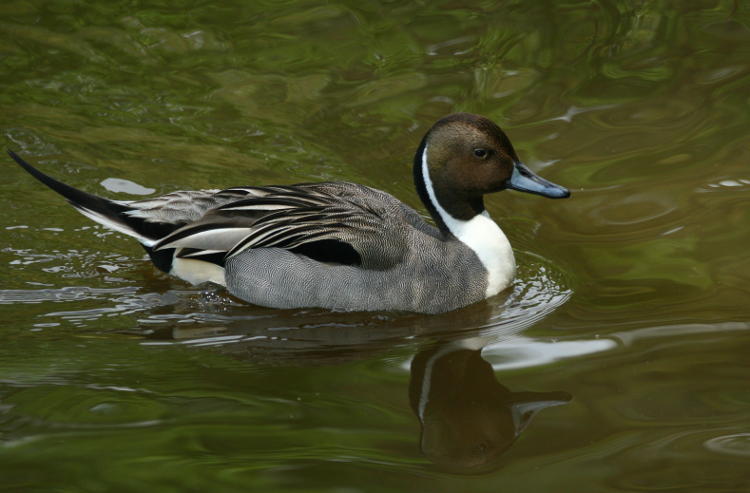
Mallards, of course, are a dime-a-dozen virtually everywhere in the US, and I usually don’t even bother with them anymore, but as one snoozed on the bank, I took the opportunity for a direct perspective.

In the case with most ducks and, really, a very wide variety of birds, the males have the brightest plumage, mostly considered by ornithologists to show off their worthiness to the females, while the females are considerably more muted in coloration, often very drab – they typically choose the males, but more importantly, they’re vulnerable to predators while on the nest, so they tend to blend in better to avoid attracting attention. There’s lots of speculation regarding the actual values of such differences, such as why the males aren’t less attractive to predators and how they determine a healthy female to court, but it must be working because it’s distinct in so many species. Yet not all.
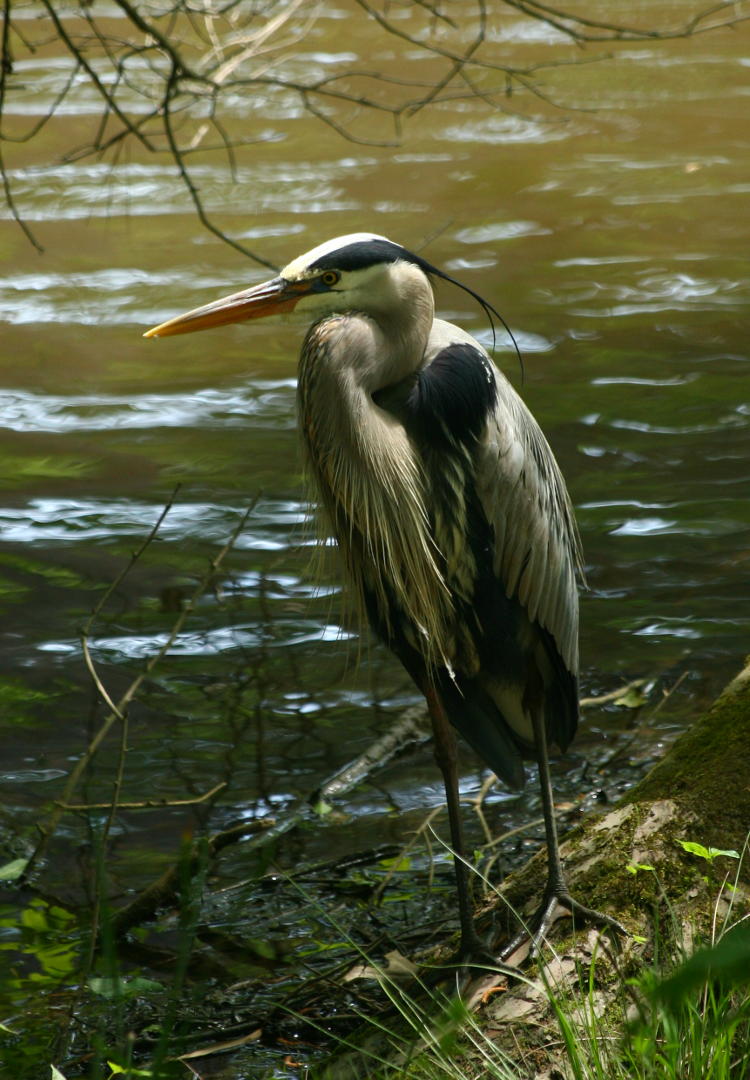
Canada geese, for instance, are difficult to tell apart by gender, as are great blue herons (Ardea herodias,) seen here. For years, there always seems to be one visible at the garden, and I suspect it’s the same one but have no way of knowing. From the size and the blue hints around the base of the beak, I’m leaning towards this one being a male – often, you have to see a pair alongside one another to feel comfortable with differentiating sexes. I couldn’t pass up this portrait, though I really wanted that twig out of the background, but whatcha gonna do? On our first pass, this one was simply dwelling in the shadows out of contact with people, perhaps digesting a small meal, but later on it became slightly more active.
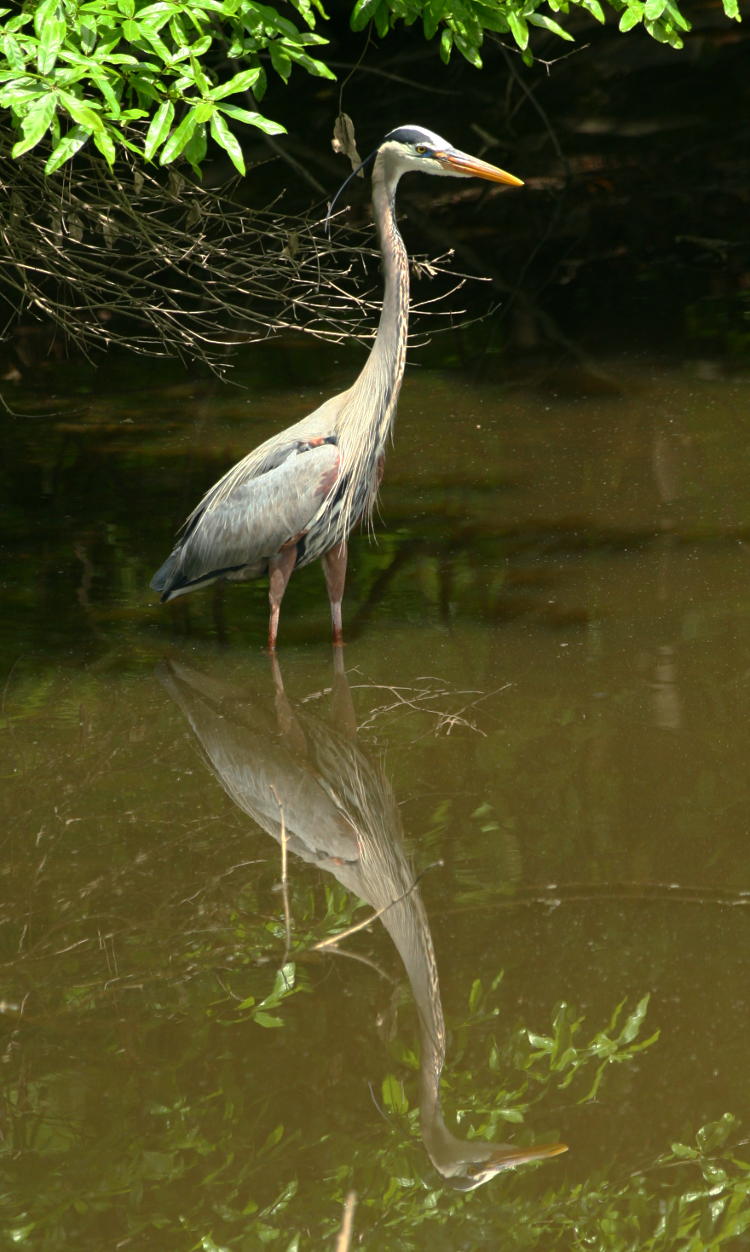
Believe it or not, the heron is in almost the same location as the previous photo, but we’re seeing it from a different vantage; the earlier shot was when it stood in those shadows behind it, and was taken from almost the opposite direction. I fired off several frames with space for that reflection, and choose this one from the limited distortion to the head and neck – ripples can make or break a water shot, especially if you’re after the reflections.
When we paused to look at the heron, it suddenly and without much warning snagged a small fish and swallowed it, in the space of a few seconds – too fast to get the cameras out (neither of us walks around with a camera in hand at all times, because it’s too easy to damage the equipment, especially when the footing might be tricky, but during pollen season it also helps keep the crud on the camera to a minimum.) Intrigued now, we waited, watching carefully, and another two minutes of patience paid off. There was a brief hint of alertness and repositioning that gave warning, and that was all.
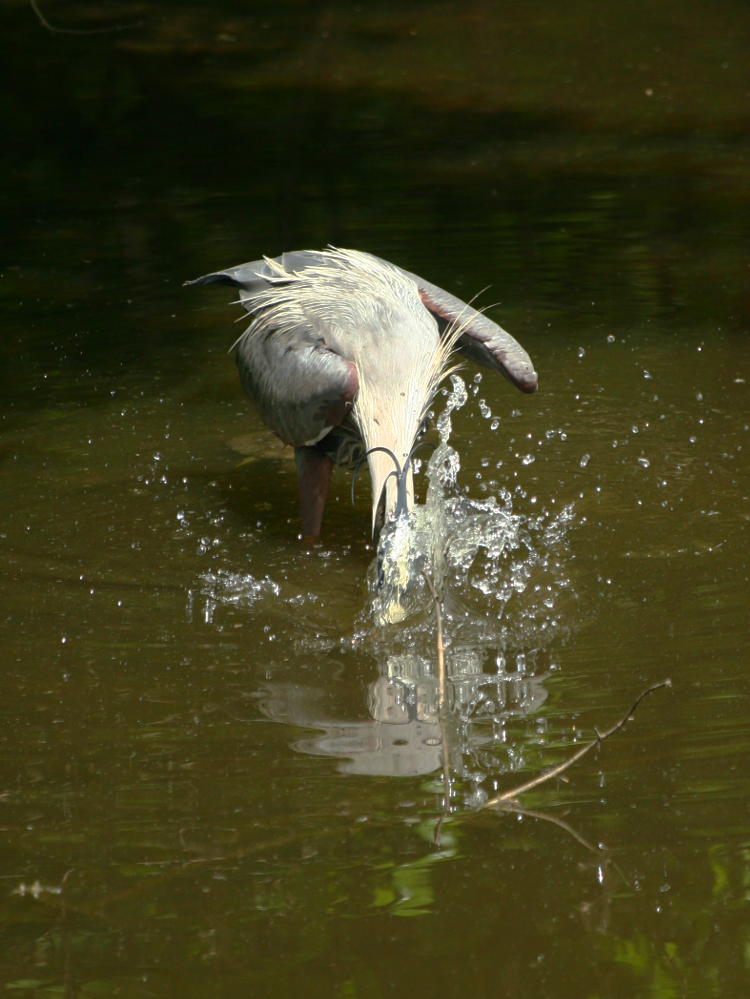
Herons are one of the easier waterfowl to catch making a capture, I have to admit, but timing still plays a role. The strike is lightning fast, because it has to be – fish, for some odd reason, try to avoid being eaten. Go figure.
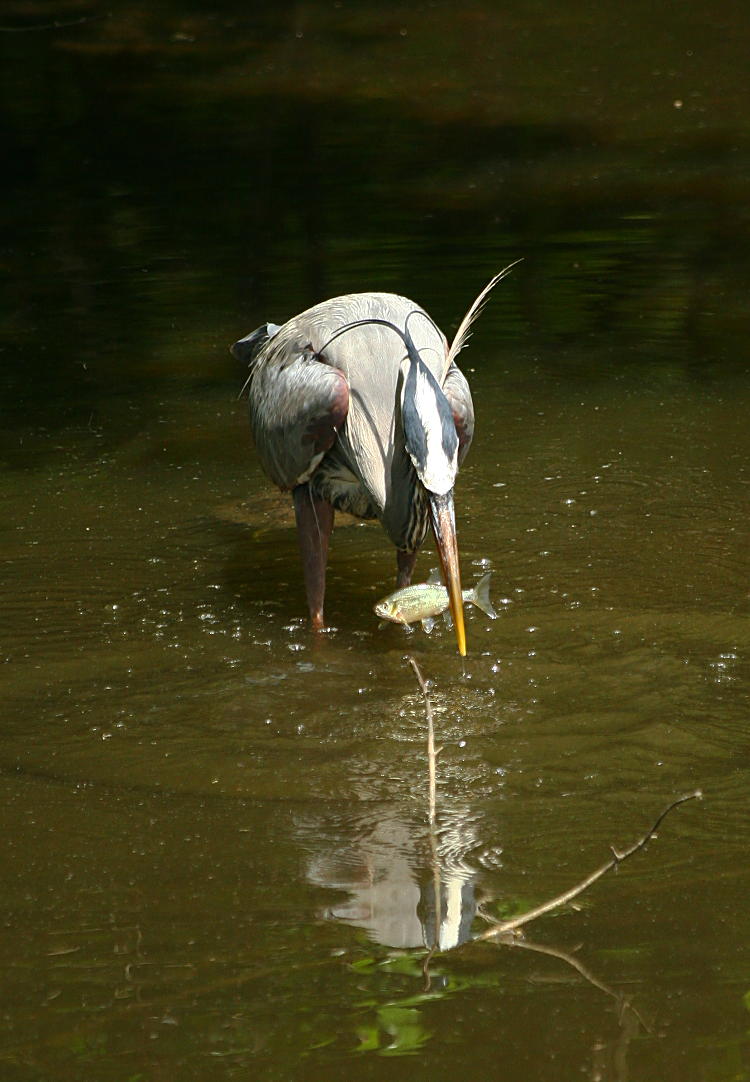
Not exactly a big meal here, but enough of them will provide, of course.
I have seen ‘the’ resident here at the gardens come down to hang out when people appeared with food for the ducks, which seemed slightly curious at first – they couldn’t care less about the duck food. Ducks are largely herbivorous and feed on submerged water plants, while herons are carnivorous and mostly feed on fish, though I’ve seen them taking out snakes and even a vole, but this means that the commercial duck food (that can be purchased from the gift shop) isn’t very palatable to herons. However, they’re good observers, and the duck food attracts turtles and especially catfish in the pond. On a previous visit, I’d watched a heron approach remarkably close to some people feeding the ducks, and did a few tight portraits as it hung out, but eventually I moved on. Less than ten seconds later, there was a splash and a cry of surprise from the people, and the heron flew past with a truly massive catfish. So much for my patience.

The heron juggled the little capture for a few seconds, getting the position right – most fish have spines along the dorsal fins which pretty much require them to have to be swallowed headfirst. So far too few have evolved spines that can face in any direction; instead, like countless other species, most fish thwart the predator aspect by reproducing in vast numbers so at least a couple offspring get through the meat grinder. Seems like an odd way to handle predation, but the “make lots” genes came out ahead of the “change body style” genes in such cases, and it still works.
Meanwhile, check out the ripples and reflections, just to show that I was lucky with the earlier portrait.
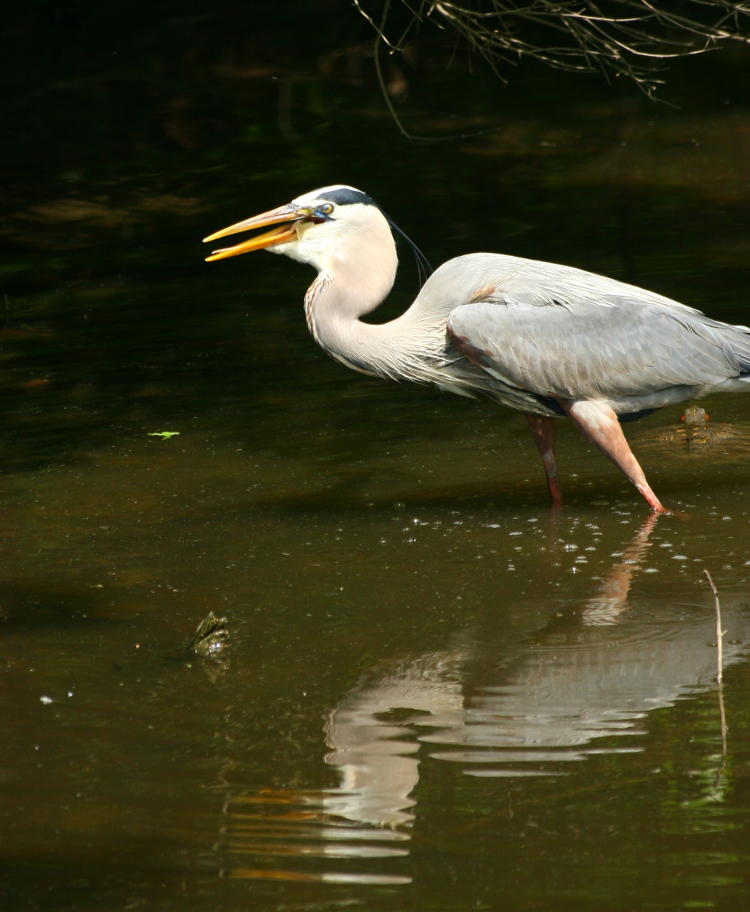
And down the little fish went. Meanwhile, I’ve been attempting to distract you from another detail visible in these two shots, one that I never spotted while shooting them, but look towards the rear of the heron. That’s a turtle head poking out (of the water,) likely a red-eared slider (Trachemys scripta elegans) – they’re not native either, but they might as well be, considering how many can be found in the area now, especially this pond. Its positioning is a little distracting, though.
Admittedly, I was in a garden so I did a few flower shots, but seriously, I consider them overdone so I tend to keep them limited, and try to find something a little different.
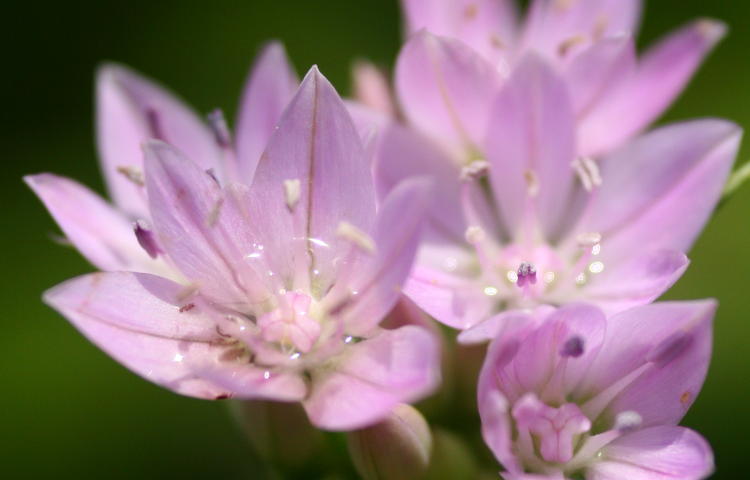
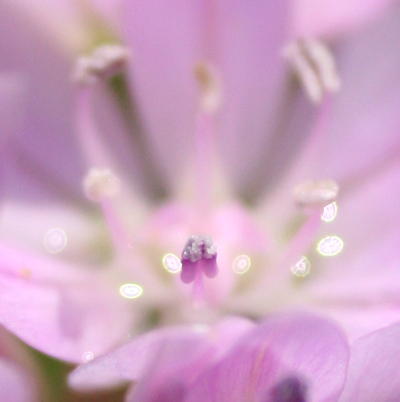 We were there late enough on a bright sunny morning, so I know this isn’t dew, but evidence of a watering system instead. I never bothered to identify these flowers, I was just after the sun on the droplets, which had an interesting effect when out of focus, as shown at right. However, I also had to try a small variation of the same framing, to show a little trick.
We were there late enough on a bright sunny morning, so I know this isn’t dew, but evidence of a watering system instead. I never bothered to identify these flowers, I was just after the sun on the droplets, which had an interesting effect when out of focus, as shown at right. However, I also had to try a small variation of the same framing, to show a little trick.
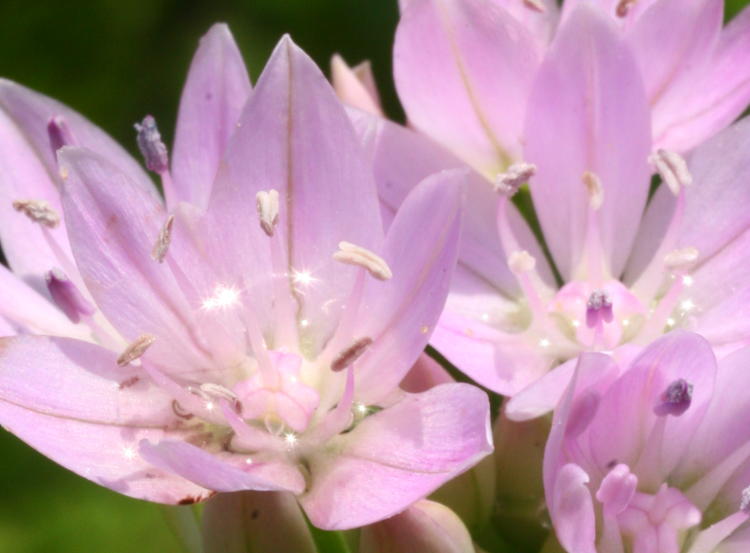
I’ve talked about this many, many times before, but with a point light source, using a small aperture can produce a starburst from it, and that little change adds a lot to the composition. I’ve done better, though.
And we’ll close with some variety of iris, I believe – there are a shit-ton of varieties and I haven’t located one that looks just like this, but we’ll go with it for now. Mostly it’s just here for the colors, but there’s this other little aspect that I saw during the sorting, that gives me the impression that they ran out of paper towels in the washroom.

As the “part 1” bit implies, there will be at least a part 2, and possibly more than that.
Storytime 18
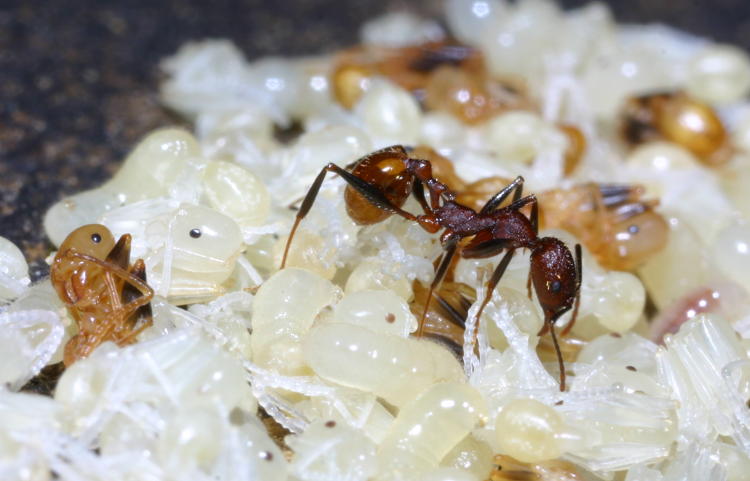
I went for a long time without anything to post, no new photos or anything, and now I have several hundred to choose from and not enough time to do anything about it. We’ll see how I fare in the next week, but it’s not looking too promising. In the meantime, we’ll do a brief Storytime post this week with a difficult capture from years ago. Turning over a rock in the yard, I revealed a significant ant nursery – these were smaller red ants, fairly common in the immediate area, harmless to people, but that’s all I can provide for identification right now. Maybe Mr Bugg will jump in with a distinct ID.
As usual, the adult workers scrambled to find someplace to conceal the hundreds of pupae that had been exposed, while I endeavored to capture this in some kind of detail. This, I should tell you, is an exercise in near-futility, for the very simple reason that ants are remarkably quick little arthropods, and move about seemingly at random – tracking them at macro magnifications and keeping them in focus is unbelievably difficult, so mostly you just pick a spot and focus and attempt to capture anything that ventures into that range. Generally, you have a fraction of a second to do so. Notice that the region of sharp focus is perhaps the width of the ant itself; in this frame, you can see the abdomen starting to get fuzzy from falling out of that range.
I was hoping for a sharp shot of one carrying away a pupa, but it was not to be within this session. Not only would focus have to be bang on, the view would pretty much have to be directly from the side, full profile as I have above, in the mere seconds before the worker made off with the pupa to a safer location. Too, it had to occur when the flash was fully-charged and ready, so after each attempt there was a period of several seconds before I could try again. The result was, I have a couple of shots from a bad perspective, but not what I wanted.
Nonetheless, there remains a great selection of pupae in varying amounts of detail, and the focus on the worker ant is pretty sharp, sharp enough to show the stippling texture of the exoskeleton itself. While not exactly what I was trying for this session, I certainly feel comfortable with keeping it.
We’re gonna have to let you go, April
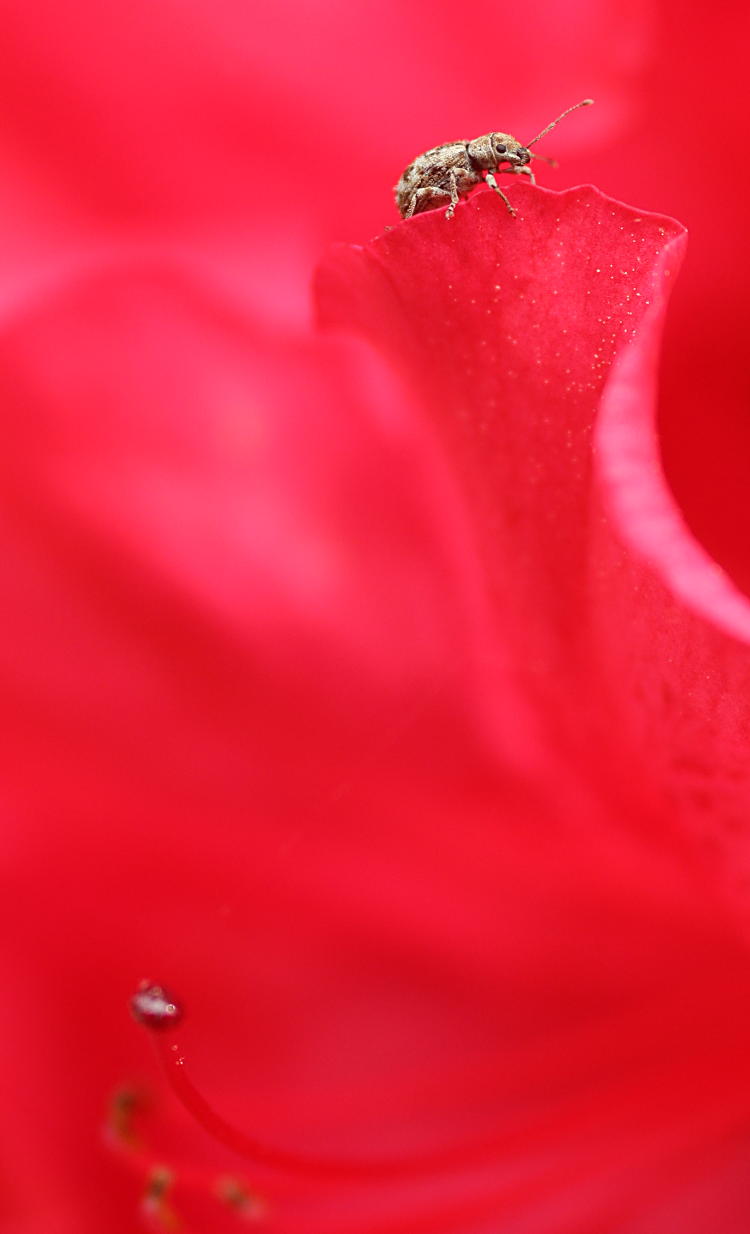
I should try a lot harder to branch out more for the end-of-the-month abstract, and not feature as many flowers and water droplets – we’ll have to see what May brings us. But I still liked the effect of this one, so I’ll just wallow in my rut for another month. At a botanical garden a few days back, I spotted this minuscule weevil on the very edge of an azalea bloom, and fired off a couple of frames wide open with the Mamiya 80 macro – this one happened to nail the focus bang on the bug. I’m tentatively identifying this as a clover weevil (Sitona hispidulus,) and if anyone tries to correct me I’ll just laugh derisively and say, “Ah, yes, many people say that.” Which is a nice way of not admitting fault while not offering a correction, either.
Another holiday is upon us

I know that you’re as aware as I am of what today actually is, and in recognition of this holiday, I almost didn’t post anything at all; what better way to celebrate National Teaser Day than to not post anything for all the people coming here throughout the day to check and see how I was celebrating it. But if I simply carried that for the whole day, people might think that I’d forgotten or wasn’t actually recognizing the holiday, perish forbid! So I’m doing double-duty and waiting until just about the last minute, and then posting an actual teaser – get as much mileage out of the holiday as possible, right? And so we have this image, which certainly should indicate that others will be along, and true to form, I’m not telling you when.
Boy, this is a fun holiday!
Storytime 17
Back in the early nineties, a couple of years after moving into North Carolina, I took my first trip alone out to the Outer Banks – I’d been once before with my cousin, a weekend camping trip, but this time around I was intent on doing some ‘serious’ photography, which at that time was still being done with an Olympus OM-10 and a variety of second-hand lenses. My workhorse was a 75-260mm zoom, which represented a long reach for me at the time – the purchase of my first modern camera, a Canon Elan IIe, was still a couple of years away, but at this point I was in the process of deciding that I’d like to pursue photography as a career (mind you, it’s still not a ‘career’ now, in most senses of the word since it’s not paying all the bills, but I can’t call it a hobby either. Some day, someone will come up with an appropriate term.)
One particular draw was all the different species that inhabit only the seaside areas. For the first seven years of my life, my exposure to the ocean had been Atlantic City, NJ, back before the casinos moved in – think Coney Island, kind of deal. Then for nearly twenty years in central NY, I had no access to the beach or ocean at all. So the Outer Banks represented this almost-exotic region to me, and among the subjects that I was pursuing were the brown pelicans (Pelecanus occidentalis.) Huge and yet leisurely, often seen gliding along effortlessly in their multi-toned plumage, I wanted some nice detail shots, which despite the wonderful reach of the 75-260 (snort,) I wasn’t getting at the distances I was normally seeing them from. I would spot them crossing the road as I was driving along Route 12, the single road that runs the length of the greater part of the Outer Banks, and find a place to stop the car and try to spot where they’d been heading, hoping they might have landed near the water’s edge or something. Generally, I saw no sign of them when I crossed the primary dune – in the time it took me to get out there, they’d moved on, likely following the air currents over the wave tops and cruising along the beach, as is their typical habit. On occasion, I saw them well offshore, sometimes floating in small groups, sometimes diving into the water after a choice meal. It was frustrating, but I never expected it to be easy, and if it was easy, what would be the charm in the resulting images?
And then, I spotted the entrance to the Hatteras Marina, and decided to check it out and see what kind of photographic opportunities it held – perhaps I’d get some picturesque shrimp netting boats alongside the dock, or maybe just a nice scenic bay area. I wasn’t thinking pelicans, really, because I expected them to be shy, avoiding the people that would be therein. So it came as a little bit of culture shock to find that pelicans were not only plentiful there, they were considered almost as vermin – they were attracted by the live bait, and the subsequent catches and post-subsequent fish entrails, that accompanied a harbor catering to fishing trips. I could practically walk up to them, and it wasn’t too difficult to find various vantages that showed them off, including this one. Shot on print film (probably Kodak Gold 400,) with the so-so Olympus lenses, it lacked the qualities that I would later demand from my slides and, further off, digital images, but it still decorated my walls for a few years.

A few older ones, before catching up
A few weeks back, the short-weeked Mr Bugg and I did a photo outing, a little early in the season when things weren’t quite up to speed, that nevertheless netted a handful of useful images, and I simply haven’t sat down to write up a post featuring them yet. Now, with a much-more successful outing just past, I’m going to put these up to allow the young whippersnapper a chance to post his own before I blow him out of the water, just for how snarky he tends to be. Respect; kids these days don’t know what it means.
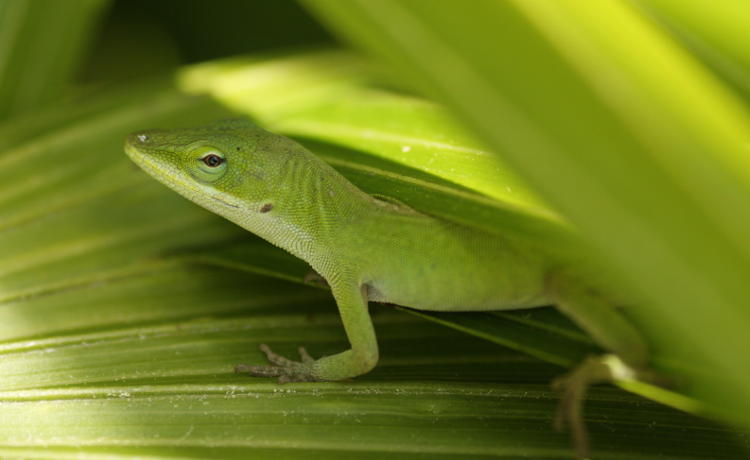
At the NC Botanical Gardens, which were still thinly-populated with plants at that time, I made it a point to try and spot my old friends the Carolina anoles (Anolis carolinensis,) which I was eventually successful at, partially because I made the special effort, and partially because I know their habits and haunts. Shot handheld in the shade under the palmetto leaf, I’m pretty pleased with how the image above came out. A few minutes later as we passed the spot again, this one had made itself scarce and was nowhere to be found.
Further away in a small pond liner, a couple of green frogs (Rana clamitans, formerly Lithobates clamitans) peeped stoically from the water, and a stealthy manner allowed quite a close approach. Being my usual self, this meant I spent the remainder of the visit with mud and grit on my knees and elbows from having gotten down as far as possible without actually slapping my belly into the marshy conditions, but I’ve never been good-looking even when cleaned up so it wasn’t particularly noticeable anyway.
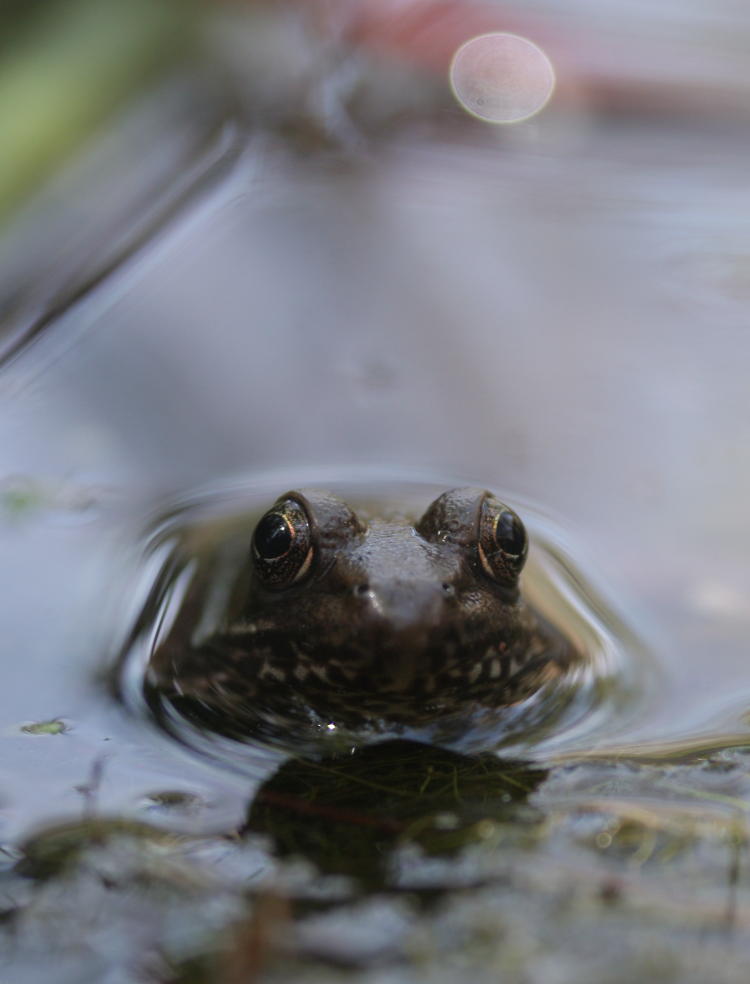
Prior to that, we’d taken a pass through Mason Farm Biological Reserve, one of the few times we could access it between the rainy periods that have existed for the past few months; the little concrete causeway that spans the creek, forming the entrance to the region, would flood out too far with the runoff from the area and prevent access. As it was, we plowed through almost half a meter of water to get in, but this meant we had the place to ourselves for hours. I prefer this, because others tend to spook off some of the animals that we’re likely to see, especially since the loop is a favorite of joggers. But despite this advantage, the day was still abnormally quiet as far as wildlife was concerned, curious because mating season was beginning and the day was quite pleasant. I think most of the species knew that we still had a couple of rather cold nights ahead of us.
But the evidence was there, if we paid attention. The alarm calls of a pair of American crows (Corvus brachyrhynchos) overhead drew our attention, and indicated that nesting season was indeed upon us.
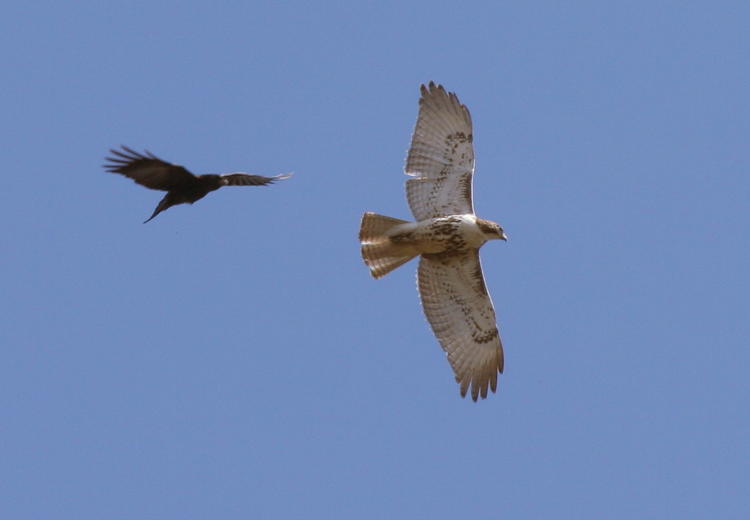
I doubt that I need to point out what a crow looks like, so the other is a red-tailed hawk (Buteo jamaicensis) that was simply riding the weak thermals of the day in lazy circles – or trying to. The fact that it was in the vicinity of a crow’s nest earned it the enmity of the pair, which were repeatedly diving at it. Red-tailed hawks are heavy and flying is energy intensive for them, so they tend to glide when the air currents permit, while crows are more agile, so the performance played out with the crows circling around from a higher position to dive in and attack the hawk from above and behind, desperately avoiding those talons, while the hawk occasionally wheeled or dodged, for the most part appearing to ignore its harassers.

These were shot from a considerable distance with the Canon 100-300 L and cropped significantly, so the first image here was clearly the best, while others suffered from bad focus tracking on my part – I was shooting in manual mode because of intervening trees and the likelihood that I’d fail to keep the autofocus point precisely on the birds, causing the AF to start winding in and out in an attempt to find the subject; when that occurs you can easily lose sight of the birds. While I don’t expect this issue to be remedied entirely, there should be some improvements in this regard shortly. For now this is what we have.

It’s a shame that I wasn’t maintaining best focus, because this is just what I was following their actions for: a better shot of actual near-contact, with the hawk momentarily making an evasive move. Should the crows have dipped down just a hair too far, the tables may have been turned, because the hawk wouldn’t hesitate to snag one of them with its superior strength, and red-tails have a pretty broad diet – the reason the crows were concerned in the first place, even if eggs weren’t actually on the nest (which seems likely because both crows were involved.) The drama played out for several minutes until the hawk, riding the air currents, had moved on sufficiently from the region for the crows to feel safe and/or vindicated.
This reminds me of another drama that I witnessed several years back, when I did not have the camera in hand. Once again hearing the alarm calls of crows, I looked up to see a turkey vulture cruising through the area, followed closely by two upset crows. Vultures are much heavier than hawks, so even less evading was taking place, and I honestly feel the vulture was just passing by when its path took it too close to a crow’s nest. They passed out of sight and I went back to what I was doing – for only a few moments. In no time at all, the crows reappeared, this time hell bent for leather in the opposite direction, closely pursued by some angry grackles; in their harassment of the vulture they had passed too close to the grackles’ nest and earned the exact same response in return. Grackles are as much smaller than crows as the crows were from the vulture, while at the same time much more agile, and it’s amusing to see larger birds fleeing in apparent fear from a smaller adversary. Size might help at times, but it’s not the key factor in altercations, at least among birds.
And I close with another shot obtained later on once I came back home, after night fell. One of my resident green treefrogs (Hyla cinerea) had ventured out and provided a fetching pose atop the gate in the backyard, and while the flash was a little inadequate for this frame, it seems to have added a more mysterious air to the whole image. I can live with it.
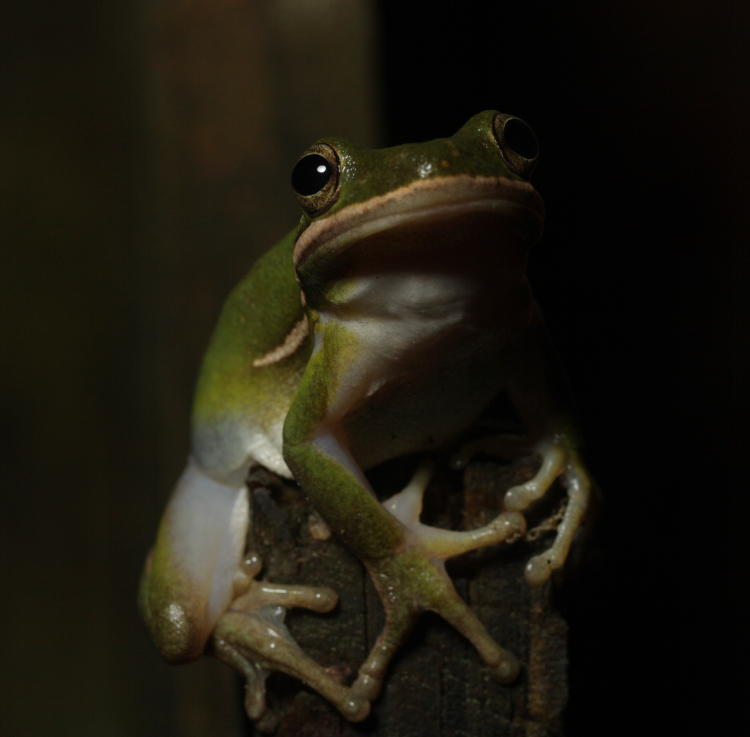
BIAB: Coldplay
As I promised/threatened/cursed in the previous Because It’s A Blog entry, we’re going to go a lot more current than my normal eighties music fare this time around and feature some Coldplay. No, I’m feeling just fine, thanks for your concern. And I will readily admit, I am your classic grumpy old man in that I find nearly all current music to fall somewhere between “meh” and horrid talent-free pap, but honestly, I was/am that way about a good portion of eighties music too – every hair band was terrible, and Whitney Houston was a pox on anyone with ears. I could attempt to explain/rationalize this, but I’ll simply go with the idea that you’re most attuned to the stuff that you were hearing during adolescence and puberty and all that, which seems to be the favored sociological explanation.
Coldplay, however, is a band I’ll happily make an exception for, or perhaps offer some observation that they capture more of the salient properties of my preferred musical tastes. I’m not actually going to try to deconstruct it too much, because I haven’t put that much thought into it; right now, I’m simply going to introduce you to a few songs on the odd chance that you’ll get something out of them. Given that Coldplay is enjoying plenty of current popularity, it’s not that odd a chance, really.
My first introduction to them came from a TV commercial, of all things – quite strange because I never watch TV. But one of their songs was featured on an iTunes ad, I think, and I was intrigued by it. A little later on I caught it again on the radio (which receives as much attention from me as TV does,) and was hooked. That song, I eventually discovered, was “Viva La Vida,” and I want you to pay particular attention to the lyrics.
Viva La Vida – Coldplay
Interpreting the meaning of a song is generally a fool’s game, because it’s almost never correct, and on top of that I’ve actually read about it direct from the source – who were admittedly pretty vague despite the distinct religious references (more specifically, the christian bible.) Nonetheless, I tend to view it as the rise and fall of the holy roman empire and the influence of the catholic church, at one time executing their enemies with the power of their authority, and now struggling to maintain relevance while dismissing the frequent accusations of sexual impropriety and ethical misconduct. The lyrics are undeniably clever, especially
And I discovered that my castles stand
Upon pillars of salt, pillars of sand.
“Pillars of salt” being a clear reference to the fate of lot’s wife as they fled sodom and gomorrah, while “pillars of sand” being slightly less direct in calling back a lecture within the gospel of matthew – more than a little tongue-in-cheek too, since that passage makes the claim that following jesus is building a house upon the rock (strong) and not the sand, while any religion is based solely and entirely on hearsay, with virtually no application to the physical, demonstrable world; a house on sand, indeed.
All that aside, musically it’s a radical departure from drum machines and spoken or chanted lyrics, and The Girlfriend and I have spent some time puzzling out what’s actually within the string arrangement that forms most of the instrumentation. Meanwhile, Chris Martin’s vocals are dynamic and rich, a far cry from the narrow range of many artists now and past, and he uses his voice well against the instruments. A lot of attention was paid to the composition and studio mixing, and it shows.
That song was enough to intrigue me, but I’ve been burned before on thinking that a single song was enough to validate a band or album (haven’t we all?) and didn’t really pursue it in the normal way, like seeking out other songs by the act to see if they compare; instead I just kind of kept it in the back of my head. Some time later, I came across the next in a haphazard way: I think a clip of it, or something trying to sound like it, was included on my new flip-phone as a ringtone, which I assigned to The Girlfriend’s number, eventually hearing it at random as the song itself. Soon afterward, a friend of mine (hearing the ringtone) remarked at it being a favorite of his, partially because of its own merits, and partially because his daughter played lead on the song when her school band did a recital. I guess I should have warned you how sordid this tale was going to get. But here’s “Clocks” anyway…
Clocks – Coldplay
No, I’m not even trying to interpret those lyrics, and in fact, I’ll only attempt to sing them when no one else can hear (the podcasting is bad enough.) Martin’s voice seems a little strained for this set, and makes me wonder when the studio recording fell (like, during a tour, or maybe after a drive through a construction zone on an interstate,) but again, the range works well, and the song plays out like a drama, building intensity and dropping off, not relying on a riff or much of a formula. Occasionally, an act comes out that demonstrates that cookie-cutter musical trends are not what listeners are really fond of, breaking genre and becoming immensely popular, and Coldplay seems to fit into that category. On top of that, they seem to like experimenting with different sounds and mixing in lots of varied instruments, which isn’t hard, really; the hard part is doing it so well and so seamlessly.
Convinced now, I started seeking out more songs by the band, and pretty soon settled on the next as my favorite – wonderfully rich, energetic, and dramatic. The trend, starting in the nineties, towards lyrics that were little more than spoken rankled me – I’m motivated by people who can vocalize, and can get behind a singer with great tone even if I can’t understand what they’re saying, which is exemplified by the bridge herein (the lyrics can be found here if you’d prefer to know.)
Every Teardrop is a Waterfall – Coldplay
By the way, if you’re already familiar with the song, then perhaps you should check out this version for a change of pace (which is quite likely to lead down a rabbit hole all its own.)
As an interesting (or not) bit of trivia, I now associate this song (Coldplay’s version, mind you) with the film Guardians of the Galaxy, not because it was in the soundtrack or even close – the soundtrack was largely hits from the seventies – but because it began playing on the car stereo as I was on my way to the theater, ending just as I arrived, and seemed to set the mood. Since it was an MP3 file, I hit it to repeat and play on my way home too.
Now, I said above that it was my favorite, and this lasted for a while until that aforementioned friend pointed me towards another that I’d somehow missed, which didn’t immediately strike me as strongly but grew quickly, and has now supplanted ‘Every Teardrop.’
[You might want to drop the volume a little for this one – the version I uploaded is a bit high.]
Charlie Brown – Coldplay
I think it’s safe to say that we’ve departed from the standard rock instrumental lineup with this one as well, and if you can interpret what’s actually being used in there, more power to you. As I was writing this post, it struck me that Coldplay almost seems to compose at least some of their music more like screenplays, with ‘acts’ that change the mood and tempo, while still remaining in the classic structure (lyrics, chorus, lyrics, chorus, bridge, chorus) of popular music, the songs becoming more eclectic and varied while not departing the genre, and this might prove to be a great formula, at least until it becomes overused. Or maybe I’m wrong, but whatever – I approve.
More useless trivia: I had been interpreting the final line incorrectly for some time, until I saw the lyrics feeding automatically through my Linux MP3 player. It is normal to believe that by this time, I had settled in on my version so well that I disliked the actual lyric, but there’s more to it than that: mine was actually much better. So I wrote to Chris Martin and told him about it and, remarkably, he agreed, and is incorporating my own into all concert performances from this point on. However, only if they’re not recorded, so I don’t have to be paid any royalties at all for this contribution. Understandably, I have mixed feelings about this.*
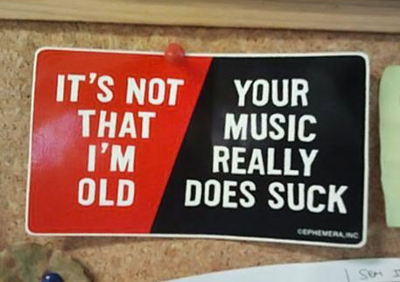 Don’t get the impression that I’m disregarding other songs that have perhaps charted better, like, “A Sky Full of Stars,” or their duet with The Chainsmokers, “Something Just Like This,” which are also powerful songs; I’m featuring this lineup both because they’re my favorites, and because not everyone has necessarily been exposed to them. But yes, a little bit of current (more or less) music sneaks into my playlists, as long as it works pretty well – yet listening to any radio station for longer than a few minutes manages to piss me off significantly. So I’m still maintaining my curmudgeonly status.
Don’t get the impression that I’m disregarding other songs that have perhaps charted better, like, “A Sky Full of Stars,” or their duet with The Chainsmokers, “Something Just Like This,” which are also powerful songs; I’m featuring this lineup both because they’re my favorites, and because not everyone has necessarily been exposed to them. But yes, a little bit of current (more or less) music sneaks into my playlists, as long as it works pretty well – yet listening to any radio station for longer than a few minutes manages to piss me off significantly. So I’m still maintaining my curmudgeonly status.
Next up, most likely, we’re going to go even further back to the seventies with a soundtrack. I know you’re excited about that.
* This is not true at all. Actually, he told me to fuck off diagonally and never contact him again.**
** Also not true – I never contacted him in any way. But I should, now that I’m prepared for all consequences.***
*** Now this is getting a bit confusing. After typing all that above, I found a link (actually, several) that showed the lyrics exactly as I had them in my mind – and one completely different version. I actually have no idea what source my player uses for the lyrics, but there’s an ‘Edit Lyrics’ function built into the console, which fills me full of confidence. So, you know? Use whatever you like – I’m not counting anything as ‘official.’




















































